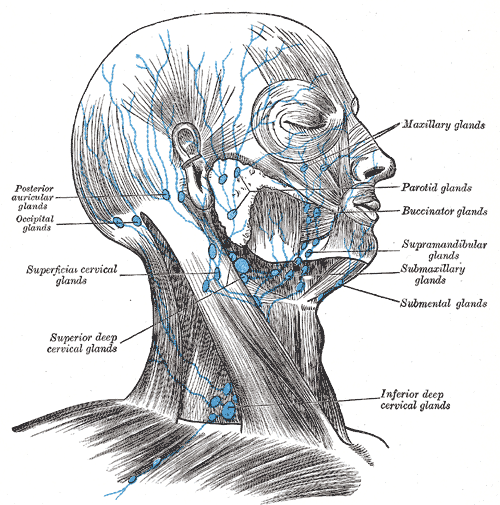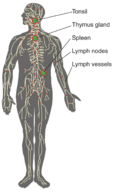3.4 淋巴系统
章节大纲
-
What do swollen lymph nodes mean?
::肿胀的淋巴结是什么意思?Lymph nodes often swell in one location when a problem, such as an injury, infection, or tumor , develops in or near the lymph node. Common sites for swollen lymph nodes include the neck, groin, and underarms.
::当一个问题,如伤害、感染或肿瘤,在淋巴结内或附近发展时,淋巴结在一个地方往往会膨胀。 肿胀淋巴结的常见地点包括颈部、腹部和下臂。Lymphatic System
::淋巴系统If manage to get through the body’s first two lines of defense, a third line of defense takes over. This third line of defense is often referred to as the immune response . This defense is specific to a particular pathogen, and it allows the immune system to “remember” the pathogen after the infection is over. If the pathogen tries to invade the body again, the immune system can launch a much faster, stronger attack. This lets the immune system destroy the pathogen before it can cause harm. The immune response mainly involves the lymphatic system.
::如果能够穿过身体头两条防线,第三条防线就占据了。第三条防线通常被称为免疫反应。第三条防线通常被称为免疫反应。这一防线是针对特定病原体的,它允许免疫系统在感染结束后“记住”病原体。 如果病原体试图再次侵入身体,免疫系统可以发动更快、更强烈的攻击。这让免疫系统在造成伤害之前就摧毁病原体。 免疫反应主要涉及淋巴系统。The lymphatic system is a major component of the immune system. Because of its important role in the immune system, the terms "immune system" and "lymphatic system" are sometimes used interchangeably. However, nonspecific defenses of the body include organs such as the skin, which is not part of the lymphatic system. In addition, the lymphatic system has another function not directly related to defense.
::淋巴系统是免疫系统的一个主要组成部分。由于淋巴系统在免疫系统中的重要作用,“免疫系统”和“淋巴系统”有时可以互换使用。然而,身体的非特定防御包括皮肤等器官,而皮肤不是淋巴系统的一部分。此外,淋巴系统还有与防御没有直接关系的另一个功能。Functions of the Lymphatic System
::复体系统功能The lymphatic system has three basic functions. The first function is related to digestion . The other functions are involved in the immune response.
::淋巴系统有三个基本功能,第一个功能与消化有关,其他功能与免疫反应有关。-
The lymphatic system absorbs
fatty acids
after the digestion of
in the
. It then transports the fatty acids to the bloodstream, where they circulate throughout the body.
::淋巴系统在消化后吸收脂肪酸,然后将脂肪酸转移到血液中,在血液中循环,在整个身体中循环。 -
The lymphatic system removes excess fluid from body
tissues
and returns the fluid to the
. The fluid is filtered as it passes through the lymphatic system, and any pathogens it contains are destroyed before the fluid enters the bloodstream.
::淋巴系统将多余的液体从身体组织中移除,并将液体返回到身体组织中。液体通过淋巴系统时经过过滤,其中所含的任何病原体在液体进入血液中之前被销毁。 -
The lymphatic system produces
lymphocytes
.
Lymphocytes
are the type of
white blood cells
, or
leukocytes
, primarily involved in the immune response. They recognize and help destroy specific foreign invaders in body fluids and
.
::淋巴系统产生淋巴细胞,淋巴细胞是白血细胞或白血球类型,主要与免疫反应有关,它们识别并帮助摧毁特定外国入侵者的身体液体和体液。
Parts of the Lymphatic System
::流体系统部分The lymphatic system, which is shown in Figure , consists of lymphatic organs, lymphatic vessels, lymph , and lymph nodes. Organs of the lymphatic system include the red bone marrow , thymus , spleen , and tonsils.
::淋巴系统由淋巴器官、淋巴类血管、淋巴类和淋巴结组成,淋巴系统的器官包括红骨髓、胸腺、脾脏和扁桃腺。-
Red bone marrow
is found inside many
including the hip, breast, and skull bones. It produces leukocytes.
::红骨髓在包括臀部、乳房和头骨骨在内的许多骨髓中被发现,产生白鲸。 -
The
thymus
is a gland located in the upper chest behind the breast bone. It stores and matures lymphocytes.
::胸腺是胸骨后胸前的腺,储存和成熟的淋巴细胞。 -
The
spleen
is a gland in the upper abdomen. It filters blood and destroys worn-out
red blood cells
. Lymphocytes in the spleen destroy any pathogens filtered out of the blood.
::脾脏是上腹部的腺,它过滤血液,摧毁破损的红细胞,脾脏中的淋巴细胞摧毁血液过滤的任何病原体。 -
Tonsils
are glands on either side of the
pharynx
in the throat. They trap pathogens, which are then destroyed by lymphocytes in the tonsils.
::肿瘤是喉咙中Pharynx两侧的腺体,它们捕捉病原体,然后被中的淋巴细胞摧毁。
The lymphatic system consists of organs, vessels, and lymph.
::淋巴系统由器官、船只和淋巴组成。Lymphatic vessels make up a body-wide , similar to the arteries and veins of the . However, lymphatic vessels circulate lymph instead of blood. Lymph is fluid that leaks out of tiny , called capillaries, into spaces between cells in tissues. At sites of inflammation, there is usually more lymph around cells, and it is likely to contain many pathogens.
::淋巴动物的体外体外体外体外体外体外体外体外体外体外体外体外体外体外体外体外体外体外体外体外体外体外体外体外体外体外体外体外体外体外体外体外体外体外体外体外体外体外体外体外体外体外体外体外体外体外体外体外体外体外体外体外体外体外体外体外体外体外体外体外体外体外体外体外体外体外体外体外体外体外体外体外体外体外体外体外体外体外体外体外体外体外体外体外体外体外体外体外体外体外体外体外体外的体外体外体外体外体外体外体外体外体外体外体外体外体外体外的体外体外体外体外体外体外体外体外体外体外体外体外体外体外体外体外体外体外体外的体外体外体外体外体外体外体外体外体外体外体外体外体外体外体外体外体外体外体外体外体外体外体外体外体外体外体外体外体外体外体外的体外体外体外体外体外体外体外体外体外体外体外体外体外体外体外体外体外体外体外体外体外体外体外体外体外体外体外体外体外体外体外体外体外体外体外体外体外体外体外体外的体外体外体外体外体外体外体外体外体外体外体外体外体外体外体外体外体外体外体外体外体外体外体外体外体外体外体外体外体外体外体外体外体外体外体外体外体外体外体外体外体外体外体外体外体外体外体外体外体外体外体外体外体外Unlike the cardiovascular system, the lymphatic system does not have a pump to force lymph through its vessels. Lymph circulates due to peristalsis of lymphatic vessels and rhythmic contractions of the that surround the vessels. Valves in the lymphatic vessels prevent lymph from flowing backwards through the system.
::与心血管系统不同,淋巴系统没有泵来迫使淋巴通过船只,淋巴由于淋巴器的持久性和船只周围的节奏收缩而循环,淋巴器中的阀门防止淋巴通过系统向后流动。As lymph accumulates between cells, it diffuses into tiny lymphatic vessels. The lymph then moves through the lymphatic system, from smaller to larger vessels, until it reaches the main lymphatic ducts in the chest. Here, the lymph drains into the bloodstream.
::当淋巴在细胞之间积累时,它会扩散到微小的淋巴容器中,然后通过淋巴系统,从小到大,从小移动到大,直到到达胸中主淋巴管。这里,淋巴进入血液。Before lymph reaches the bloodstream, pathogens are filtered out of it at lymph nodes. Lymph nodes are small oval structures located along the lymphatic vessels that act like filters. Any pathogens filtered out of the lymph at lymph nodes are destroyed by lymphocytes in the nodes.
::淋巴病原体在淋巴节点被过滤出来,淋巴节点的淋巴节点是淋巴类容器上小型的奥瓦尔结构,类似于过滤器,淋巴节点从淋巴体中过滤出来的病原体在结点被淋巴细胞摧毁。Lymphocytes
::淋巴细胞Lymphocytes are the key cells involved in the immune response. There are an estimated two trillion lymphocytes in the , and they make up about 25 percent of all leukocytes. Usually, fewer than half of the body’s lymphocytes are found in the blood. The rest are found in the lymphatic system, where they are most likely to encounter pathogens.
::淋巴细胞是免疫反应的关键细胞。 估计有2万亿淋巴细胞,占所有白血球的25%左右。 通常,在血液中发现不到身体淋巴细胞的一半。 其余的在淋巴系统中发现,那里最有可能出现病原体。The immune response depends on two types of lymphocytes: B lymphocytes (or B cells) and T lymphocytes (or T cells). Both types of lymphocytes are produced in the red bone marrow. The two types are named for the sites where they mature. B cells mature in the red bone marrow, and T cells mature in the thymus. Both B and T cells can recognize and respond to specific pathogens. B or T cells that respond to the body’s own molecules as though they were foreign, or “non-self,” receive a signal that causes them to die. Only those B and T cells that have shown they are unlikely to react to “self” molecules are released into circulation.
::免疫反应取决于两种淋巴细胞:B 淋巴细胞(或B细胞)和T 淋巴细胞(或T细胞)。两种淋巴细胞都是在红骨髓中生成的。两种淋巴细胞都是在它们成熟的地方命名的。B 细胞在红骨髓中成熟,T 细胞在胸腔中成熟。B 细胞和T 细胞可以识别和响应特定的病原体。B 或T 细胞对身体自身的分子反应,好像它们是外来的或“非自我的 ” , 接受一种导致它们死亡的信号。 只有那些表明它们不可能对“自我” 分子作出反应的B 和 T 细胞才被释放到循环中。Summary
::摘要-
The lymphatic system is responsible for the removal of excess fluid from tissues, the absorption of fats, and the production of certain white blood cells.
::淋巴系统负责清除组织中的多余液体、吸收脂肪和生产某些白血细胞。 -
Lymph originates as blood plasma that leaks from the capillaries and becomes part of the interstitial fluid.
::淋巴素是血浆产生的 血液血浆从刺青中泄漏出来 成为间隙液的一部分 -
The lymphatic system has many lymph nodes that filter or trap foreign particles.
::淋巴系统有许多淋巴结,可以过滤或捕捉外来微粒。 -
The movement of lymph depends on the movement of skeletal muscles to squeeze the lymph through them. Valves in lymph vessels make sure that lymph only moves in one direction.
::淋巴的移动取决于骨骼肌肉通过淋巴挤压淋巴的移动。淋巴容器中的阀门确保淋巴只朝着一个方向移动。 -
The immune response depends on two types of lymphocytes: B lymphocytes (or B cells) and T lymphocytes (or T cells).
::免疫反应取决于两种淋巴细胞:B淋巴细胞(或B细胞)和T淋巴细胞(或T细胞)。
Review
::回顾-
What are the three functions of the lymphatic system?
::淋巴系统的三个功能是什么? -
What is the thymus, and what is its role in the lymphatic system?
::胸腺是什么,它在淋巴系统中的作用是什么? -
How does lymphatic circulation work?
::淋巴循环如何运作? -
Where do B cells and T cells mature?
::B 单元格和 T 单元格在哪里成熟?
-
The lymphatic system absorbs
fatty acids
after the digestion of
in the
. It then transports the fatty acids to the bloodstream, where they circulate throughout the body.

